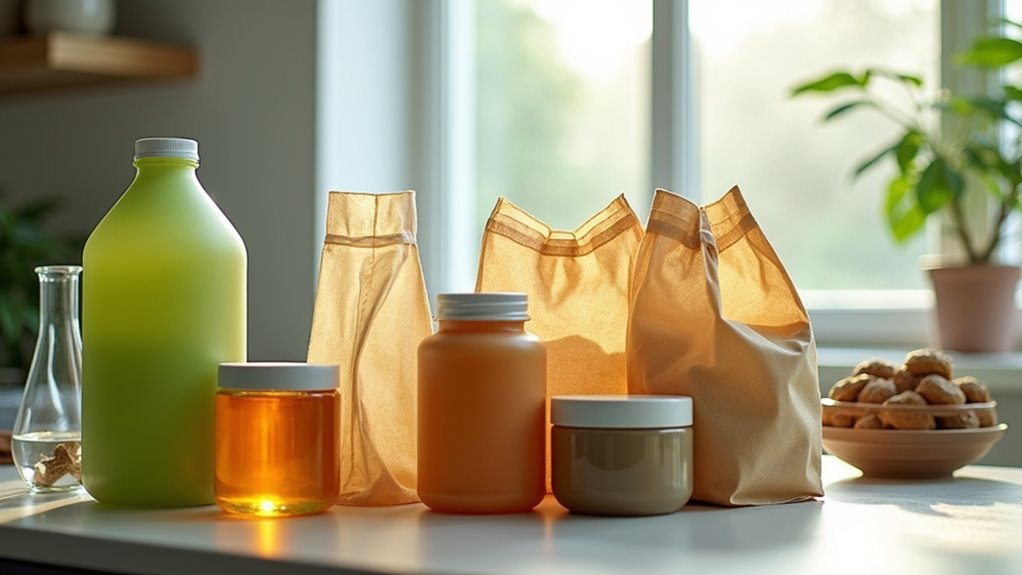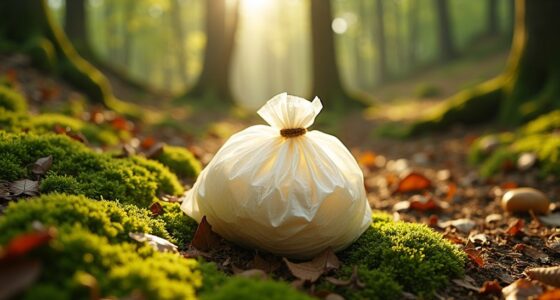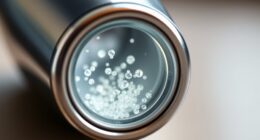Bio‑based plastics are eco-friendly materials made from renewable resources like plants and algae, offering a sustainable alternative to traditional plastics. Their advantages include reduced reliance on fossil fuels, lower greenhouse emissions, and biodegradability. However, challenges remain, such as higher production costs, recycling difficulties, and land use concerns. Understanding these benefits and hurdles helps you see how bioplastics fit into a greener future—exploring further reveals the full potential and limitations.
Key Takeaways
- Bio-based plastics are derived from renewable biomass sources like plants and algae, offering alternatives to fossil-based plastics.
- They include both biodegradable types (e.g., PLA, PHA) and non-biodegradable “drop-in” plastics with lower carbon footprints.
- Advantages include reduced fossil fuel dependence, lower greenhouse emissions, and support for waste reduction and circular economy.
- Challenges involve higher production costs, land use concerns, potential environmental impacts, and complex waste management.
- Ongoing innovations aim to improve performance, diversify feedstocks, and address sustainability and economic barriers.
Understanding Bio‑Based Plastics and Their Types
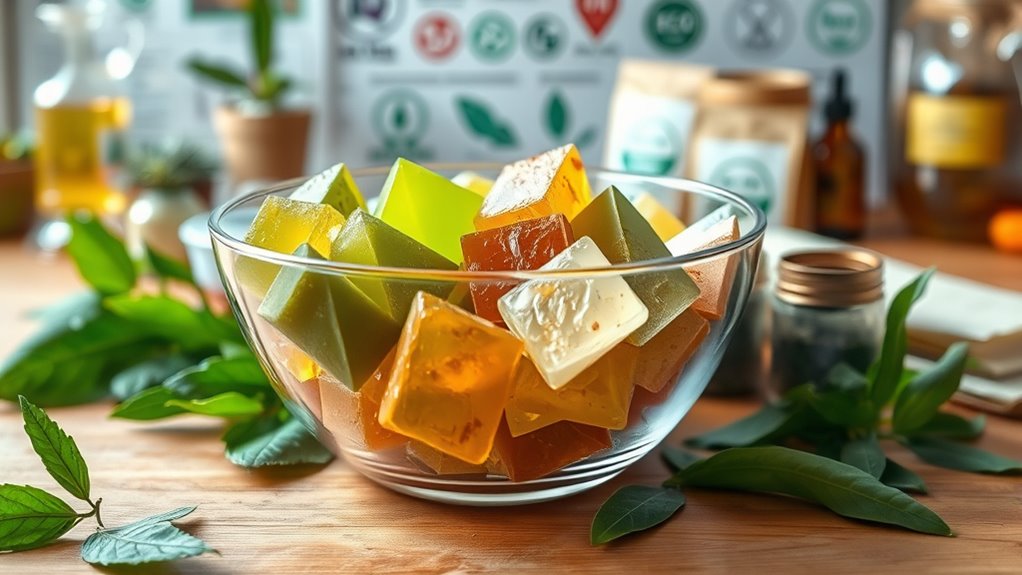
Bio-based plastics are materials made wholly or partly from renewable resources like plants, algae, or microorganisms. They fall into three main categories: bio-based durable plastics, such as biobased polyethylene (PE); bio-based biodegradable plastics like polylactic acid (PLA) and polyhydroxyalkanoates (PHA); and fossil-based biodegradable plastics like PBAT. Some bio-based plastics, called “drop-in” bioplastics, chemically match their fossil counterparts but have a smaller carbon footprint. The key difference between these types lies in their function: durability versus compostability, which determines how they’re recycled or biodegrade. Bio-based plastics can be produced using various methods such as fermentation, biotechnological processes, or chemical synthesis. Keep in mind, “bio-based” refers to origin, while “biodegradable” relates to end-of-life behavior. Understanding these distinctions helps clarify the variety and purpose of bio-based plastics.
Environmental Benefits of Bio‑Based Plastics
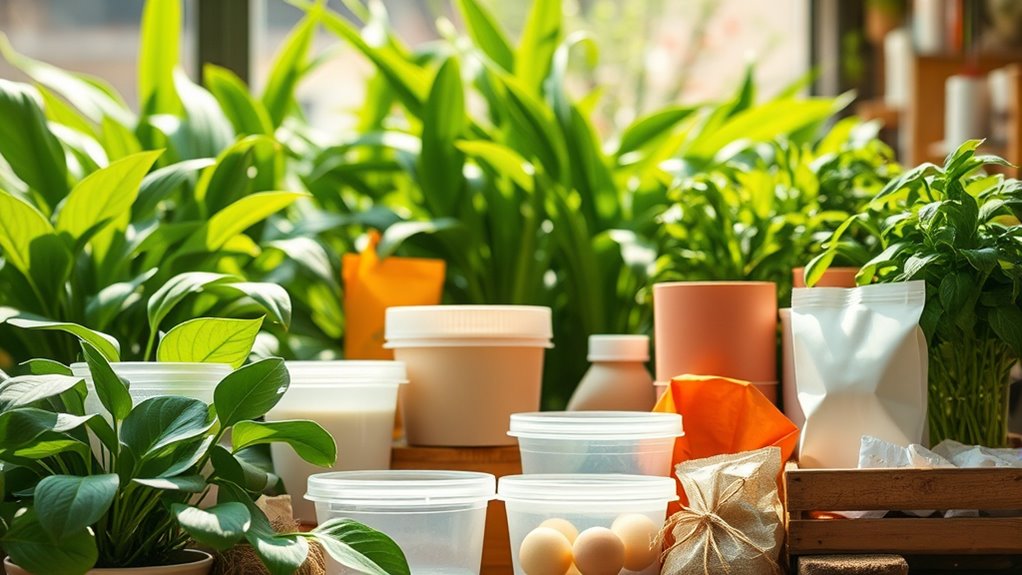
Using renewable resources in manufacturing, bioplastics offer significant environmental benefits by reducing reliance on fossil fuels and lowering greenhouse gas emissions. They conserve resources by utilizing plants and other renewable materials, which can be replenished naturally. Producing bioplastics often results in a smaller carbon footprint and can even achieve carbon neutrality depending on the feedstock. Additionally, bioplastics help reduce waste through biodegradability and recyclability, supporting a more sustainable lifecycle. They also promote a closed-loop system by enabling reuse and energy recovery. Furthermore, bioplastics’ environmental advantages are supported by their potential to contribute to EU’s 2030 greenhouse gas reduction targets and to enable resource efficiency through closed cycles and cascades. Here’s a quick overview:
| Benefit | Explanation | Impact |
|---|---|---|
| Resource Conservation | Uses renewable plant materials | Less fossil fuel reliance |
| Emissions Reduction | Produces fewer greenhouse gases | Climate protection |
| Waste Reduction | Biodegradable and recyclable | Less environmental waste |
| Carbon Neutrality | Potential for net-zero emissions | Climate goals alignment |
| Recycling & Reuse | Supports closed-loop systems | Sustainable economy |
Production Methods and Technological Advances
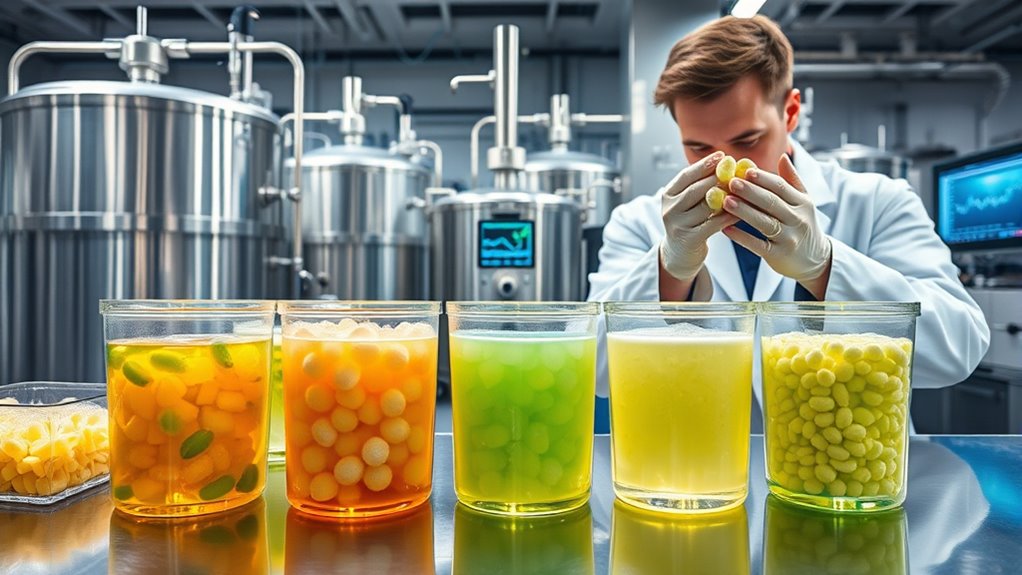
Advances in production methods and technology are driving the growth of bioplastics by making their manufacturing more efficient and sustainable. You can produce bioplastics from renewable biomass like corn, sugarcane, and potatoes using fermentation processes. Microbial reactions, especially bacteria converting feedstocks into polymers such as PHA, are central to this. This biotechnological approach allows for the sustainable production of bioplastics with reduced environmental impact. Existing plastic manufacturing infrastructure is often repurposed to produce bioplastics chemically similar to traditional plastics. Recent technological breakthroughs, like genetic engineering, enhance bacteria’s efficiency, while nanotechnology enables advanced synthesis methods. New techniques also diversify feedstocks, reducing reliance on limited resources. The use of renewable biomass as feedstock is crucial for sustainability and reducing fossil fuel dependence. Processing steps like centrifugation, filtration, extrusion, and blending ensure high-quality production. These innovations help integrate bioplastics into the circular economy, although scaling and cost remain ongoing challenges.
Diverse Applications Across Industries

Have you ever wondered how bioplastics are transforming various industries? They’re making a big impact across sectors like packaging, automotive, consumer goods, and agriculture. In packaging, bioplastics account for nearly half of the market, used for wrapping organic foods and premium products. Rigid types like PLA and bio-PET are common in cosmetics and beverage bottles, with brands like Coca-Cola exploring plant-based bottles. In automotive, bio-based polypropylene helps reduce dependency on fossil fuels while maintaining performance, contributing to lighter vehicles and better fuel efficiency. Consumer electronics and household appliances also benefit from bioplastics, lowering environmental footprints without sacrificing quality. In agriculture, biodegradable mulch films and seed coatings promote sustainable farming by reducing plastic waste and encouraging circular practices. Additionally, understanding the symbolism behind certain colors and symbols associated with bio-based products can help consumers make more environmentally conscious choices. These applications showcase bioplastics’ versatility and potential in creating a greener future.
Economic Factors and Cost Considerations

Producing bio-based plastics generally costs more than manufacturing traditional fossil-based plastics because of higher raw material expenses, such as biomass feedstocks and agricultural residues. R&D investments also raise costs, as technologies are still developing and scaling up. Limited economies of scale mean you can’t yet benefit from mass production savings common in fossil industries. Additionally, costs for cultivating, harvesting, and processing biomass—along with water and land use—add to expenses. Transportation and energy for biomass conversion further increase operational costs. Furthermore, the current supply chains for biomass are less mature, which can lead to higher logistics costs. Developing efficient supply chain management strategies is crucial to reduce these costs over time. Here’s a quick overview:
| Factor | Impact | Consideration |
|---|---|---|
| Raw material costs | Higher due to biomass reliance | Limited by feedstock availability |
| R&D investments | Increase expenses | Still emerging technology |
| Scale & infrastructure | Costly without economies of scale | Infrastructure development needed |
Challenges in Recycling and Waste Management

Why is managing bioplastics waste so challenging? Most bioplastics need specialized composting facilities to break down properly, but these are often lacking, especially in developing countries. You also need to separate bioplastics from other waste streams, which many waste systems aren’t equipped to do. Limited infrastructure Current recycling technologies aren’t well-suited for diverse bioplastic types, making recycling difficult. Landfills pose another problem, as bioplastics can last for centuries and release methane. Composting requires specific high-temperature conditions and active microbial communities, which aren’t always available. Additionally, variations in biodegradation rates and the presence of toxic chemicals complicate the process further. Bioplastic composition and contamination and lack of standardization hinder effective waste management, increasing environmental risks and making sustainable disposal a complex challenge.
Sustainability Concerns and Land Use Impact

Bioplastics offer significant environmental benefits, such as reducing greenhouse gas emissions and lowering energy consumption during production. However, they also pose sustainability concerns related to land use. Producing bioplastics from plant-based feedstocks requires agricultural land, which can lead to deforestation, biodiversity loss, and soil degradation if not managed sustainably. Large-scale cultivation of crops like corn and starch can increase eutrophication and demand more land compared to fossil-based plastics. Using agricultural residues and waste helps reduce these impacts by avoiding dedicated crop cultivation. Life cycle assessments highlight the importance of analyzing land use change to minimize environmental harm. Incorporating sustainable farming practices is essential to ensure that land use for bioplastics does not contribute to environmental degradation. Balancing the benefits of reduced emissions with responsible land management is vital to guarantee that bioplastics truly support sustainability goals.
Future Outlook and Opportunities in Bioplastics
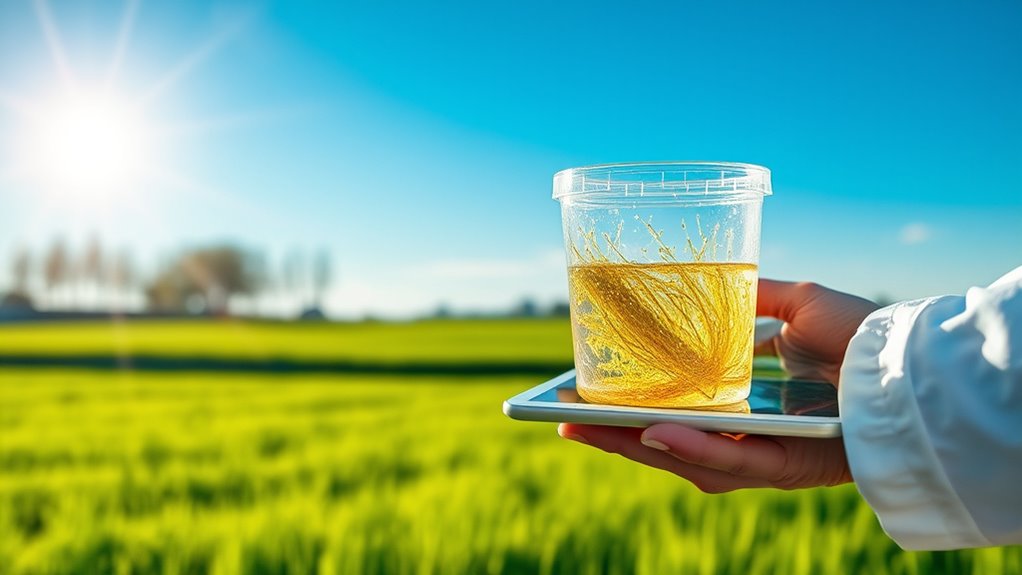
The future of bioplastics looks promising as market growth accelerates rapidly to meet rising demand driven by environmental concerns. From 2.2 million tons in 2022, the market is projected to reach 7.4 million tons by 2028, with a CAGR of 18.3%.
Manufacturers are scaling up production to keep pace, and innovations are expanding product applications across industries like packaging, textiles, and agriculture. Leading companies such as NatureWorks, BASF, and Novamont are pioneering biodegradable solutions, supporting a circular bioeconomy.
Opportunities lie in mainstream adoption, improved performance, and diversified feedstocks, which can reduce costs and boost sustainability. As awareness grows, bioplastics are set to become integral to environmentally friendly products, helping reduce dependence on fossil fuels and lowering greenhouse gas emissions. High-quality materials and advanced processing techniques will play a crucial role in overcoming current performance limitations.
Frequently Asked Questions
How Do Bio-Based Plastics Compare to Traditional Plastics in Durability?
You might wonder how bio-based plastics hold up against traditional plastics in durability. Generally, bioplastics like PLA have lower strength and heat resistance, making them suitable mainly for single-use items.
Bio-PBS offers better durability but is pricier. While advances are improving bioplastics’ resistance, they still lag behind conventional plastics in toughness and long-term use.
However, ongoing innovations could soon narrow this gap, enhancing their practical applications.
Are Bio-Based Plastics Safe for Food Contact Applications?
You might wonder if bio-based plastics are safe for food contact. While they often perform similarly to traditional plastics, safety depends on avoiding contaminants like pesticides, heavy metals, and allergens.
Regular testing and strict compliance with food safety regulations are essential. Stay informed about potential risks, and choose products from reputable sources that meet safety standards to guarantee your food remains safe and free from harmful substances.
What Policies Support the Adoption of Bio-Based Plastics Globally?
Imagine a world where every plastic bottle you see is made from renewable resources—that’s what global policies aim to create. These policies support bio-based plastics through international standards, regulations, and certifications, ensuring safety and sustainability.
Governments also offer incentives like tax breaks, research funding, and mandates to boost adoption. When countries align their efforts, it’s like building a bridge toward a greener future, making bio-based plastics more accessible worldwide.
How Can Consumers Identify Biodegradable Bio-Based Plastics?
To identify biodegradable bio-based plastics, look for eco-labels or certification logos like ASTM D6400 or EN 13432, which confirm biodegradability.
Check packaging for terms like “bio-based,” “compostable,” or “biodegradable,” and review disposal instructions to guarantee proper breakdown in suitable environments.
Be aware that visual cues can be misleading, so rely on verified labels and manufacturer information, and use online resources or apps to verify claims.
What Innovations Are Emerging to Improve Bio-Based Plastic Recyclability?
Imagine a future where recycling bio-based plastics becomes effortless, like magic transforming waste into treasure. You’ll see innovations like the ReBioCycle project’s advanced sorting and chemical recycling that can handle entire batches of bioplastics, making them as recyclable as everyday plastics.
Researchers develop stronger, more durable composites for reuse, and new technologies seamlessly integrate with existing systems. These breakthroughs promise a circular bioeconomy where plastics live longer, smarter, and more sustainably—changing how you recycle forever.
Conclusion
You now see how bio-based plastics are transforming our world, offering incredible environmental benefits and endless possibilities. While challenges like recycling and land use remain, ongoing innovations promise a future where these materials could revolutionize industries and save our planet from disaster. Don’t underestimate their power—bio-based plastics could be the game-changer that saves humanity from the brink of environmental collapse. Embrace this green revolution, and be part of shaping a sustainable tomorrow!
